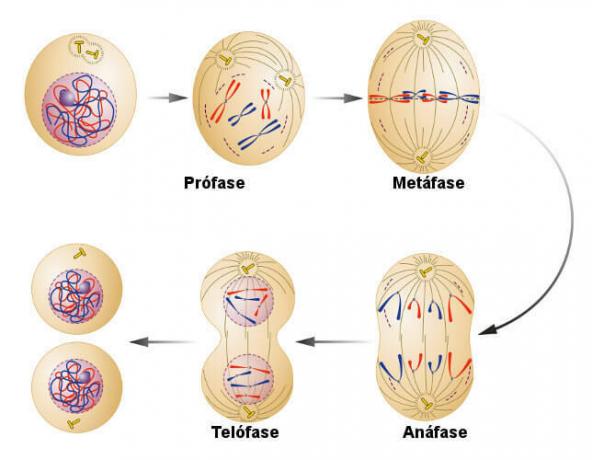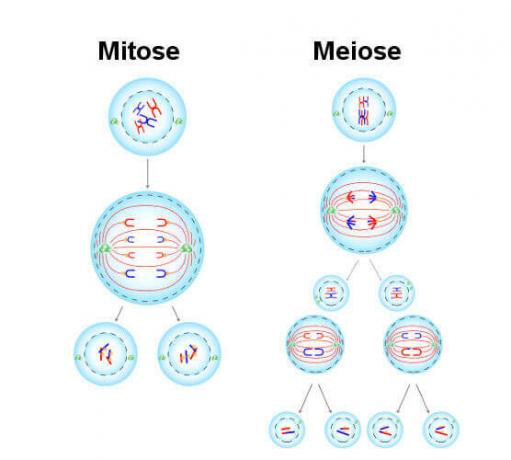At differences between meiosis and mitosis, two processes of cell division, are mainly in the number of cells produced at the end of the process and in the number of chromosomes presented by these cells.
→ Table with the differences between mitosis and meiosis
Each type of cell division has its particularity, making it easy to differentiate these two processes. See the table below with the main differences between mitosis and meiosis:
Mitosis |
Meiosis |
|
Number of daughter cells |
Two daughter cells are produced. |
Four daughter cells are produced. |
Number of chromosomes |
Daughter cells have the same number of chromosomes as the original cell. |
Daughter cells have half the number of chromosomes as the original cell. |
Number of cell divisions |
One |
Two consecutive divisions |
Phases |
Prophase, metaphase, anaphase and telophase. |
Prophase I, metaphase I, anaphase I, telophase I, prophase II, metaphase II, anaphase II and telophase II. |
Main functions in plants and animals |
Allows growth, repair and development of animals and plants. |
Produces gametes in animals and spores in plants. |
Mitosis
THE mitosis it is a cell division process that has the following steps: prophase, metaphase, anaphase and telophase. At the end of the process, the occurrence of cytokinesis is observed, which is characterized by the division of the cell's cytoplasm.
Read too: Cell core
→ Stages of mitosis

Look closely at a schematic representing the phases of mitosis.
Mitosis begins with the phase of prophase, in which the disappearance of the nucleolus (region where the ribosomes are produced) and the increase in the condensation of chromosomes, which were already duplicated before the beginning of cell division, are observed. In addition, there is the fragmentation of the nuclear membrane, the connection of microtubules (protein structures) with the chromosomes and the separation of the centrosomes (the place where the microtubules are organized).
At metaphase, the chromosomes are organized in the middle of the cell, more precisely in the metaphase plate. It is at this stage that the greatest degree of condensation is observed. At anaphase, the separation of sister chromatids (DNA molecules originated from the duplication of the original molecule) occurs, which migrate to the poles, so at the end of the process, the cell has the same number of chromosomes in each far end.
THE telophase it is the last stage, which is characterized by the formation of two nuclei. Nuclear membranes appear, and the nucleolus reappears. At the end of division, the cell's cytoplasm divides (cytokinesis), and two daughter cells are formed.
At the end of mitosis, we therefore have:
formation of two daughter cells;
cells with the same number of chromosomes as the mother cell.
Read too: Cancer, a disease that is directly related to cell division
→ Meiosis

Meiosis has two cell divisions: meiosis I and meiosis II.
THE meiosis it is a cell division process that has two consecutive cell divisions, which are called meiosis I and meiosis II. In meiosis I, we have prophase I, metaphase I, anaphase I, telophase I and cytokinesis. In meiosis II, we have prophase II, metaphase II, anaphase II, telophase II and cytokinesis.
→ Meiosis phases
Meiosis starts with the prophase I and, like mitosis, it starts with the chromosomes being duplicated. In prophase I, the movement of the centrosomes, the breakdown of the nuclear membrane, the beginning of the condensation of the chromosomes and the binding of microtubules on each homologous chromosome (chromosome equal in length and that has genes for it feature). In this phase, the pairing of homologous chromosomes also takes place, being possible the occurrence of the crossing over(exchange of genetic material between chromatids).
At metaphase I, homologous chromosome pairs organize themselves in the middle of the cell. It is worth noting that, while the two chromatids of a homologue are connected to the microtubules of one pole, the homolog is connected to the other pole. At anaphase I, homologues move to opposite poles.
At telophase I, each pole of the cell has a set formed by duplicated chromosomes that corresponds to half of the chromosome set of the initial cell, that is, a haploid set. After telophase, the cell divides, forming two.
Meiosis II is then started in each of the two cells formed. For the beginning of this stage, there is no duplication of genetic material. At prophase II, the migration of chromosomes towards the central region of the cell begins. At metaphase II, the chromosomes are arranged on the metaphase plate. At anaphase, migration of chromatids to opposite poles occurs. At telophase II, nuclei form, chromosome decondensation begins, and cytokinesis occurs in each of the two cells that initiated meiosis II.
At the end of meiosis, we therefore have:
formation of four daughter cells;
cells with half the number of chromosomes as the mother cell.

Note the diagram that illustrates the processes of mitosis and meiosis.
→ Exercises on Mitosis and Meiosis
Question 1:
(FGV) One of the differences between meiosis, in relation to mitosis, is that in meiosis the daughter cells are genetically different from the mother cell. This statement is:
a) Wrong. In both mitosis and meiosis, daughter cells are genetically the same as the mother cell.
b) Wrong. What differentiates mitosis from meiosis is the fact that in the former four daughter cells are produced, while in meiosis only two are produced.
c) Wrong. In meiosis, daughter cells have only half the initial number of chromosomes, yet each of them has the same alleles present in the mother cell.
d) Correct. O crossing over and the segregation of sister chromatids, in the second division, promote the recombination of genetic material inherited from the mother cell.
e) Correct. The segregation of homologous chromosomes, in the first division, results in daughter cells with different allelic sets in relation to that of the mother cell.
Resolution:
Letter e. In meiosis, daughter cells have half the number of chromosomes as the mother cell.
Question 2:
(UEL) Consider the following events:
I. genetic recombination
II. Segregation of homologous chromosomes
III. Segregation of sister chromatids
IV. Alignment of chromosomes on the equatorial plate.
Of these, those that occur in both mitosis and meiosis are only.
a) I and II.
b) I and III.
c) II and III.
d) II and IV.
e) III and IV.
Resolution:
Letter e. Genetic recombination is observed only in the process of meiosis, as well as the segregation of homologues. The segregation of sister chromatids and the alignment of chromosomes on the equatorial plate are events that occur in both meiosis and mitosis.



